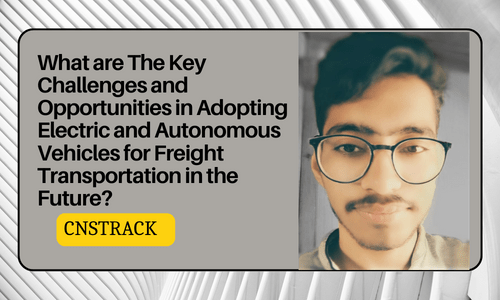Electric and autonomous vehicles for freight Transportation: The transportation industry is on the cusp of a significant transformation, with electric and autonomous vehicles poised to reshape the way goods are moved from point A to point B.
While these innovations hold immense promise, they also bring a unique set of challenges. In this blog post, we’ll explore the key hurdles and opportunities associated with adopting electric and autonomous vehicles for freight transportation in the future.
The Promise of Electric and Autonomous Freight Transportation
Electric and autonomous vehicles offer a myriad of advantages for freight transportation:
- Environmental Sustainability: Electric vehicles (EVs) are eco-friendly, producing zero tailpipe emissions. This addresses concerns about air quality and greenhouse gas emissions, making them a crucial component of sustainable transportation.
- Cost Savings: EVs have lower operating costs compared to traditional diesel trucks. Fewer moving parts result in reduced maintenance expenses, and electricity is often cheaper than diesel fuel. Autonomous vehicles can potentially reduce labor costs.
- Efficiency and Safety: Autonomous vehicles have the potential to reduce human errors, which are a leading cause of accidents on the road. They can operate around the clock, increasing efficiency and reducing delivery times.
- Urban Planning: Electric and autonomous vehicles can contribute to smarter urban planning, reducing traffic congestion, noise pollution, and the need for large parking areas.
Challenges on the Road Ahead
Despite the promise, several challenges must be overcome:
- Infrastructure: Widespread adoption of electric vehicles requires a robust charging infrastructure. The logistics industry needs to invest in charging stations and adapt to the longer charging times compared to refueling with gasoline or diesel.
- Range Anxiety: EVs often have a limited range compared to traditional vehicles. This can be a significant constraint for long-haul freight transportation.
- Battery Technology: Battery technology must continue to improve to extend the range, reduce costs, and enhance the lifespan of EV batteries.
- Regulations and Safety: The regulatory environment for autonomous vehicles is evolving, and safety standards must be established and met to ensure the safe operation of these vehicles.
- Cybersecurity: Autonomous vehicles are vulnerable to cyberattacks, making cybersecurity a top priority in their development and deployment.
- Workforce Transition: The adoption of autonomous vehicles may disrupt the trucking labor force, necessitating workforce training and transition plans.
Related Post: How Lean Logistics Practices Revolutionize Supply Chains for Efficiency and Sustainability
Opportunities for Innovation
- Data Analytics: Harnessing data from autonomous vehicles can lead to better route optimization, predictive maintenance, and real-time tracking, improving overall supply chain efficiency.
- Multi-Modal Integration: Combining electric and autonomous vehicles with other transport modes, such as trains and drones, can create more integrated and efficient logistics networks.
- Last-Mile Delivery: Electric and autonomous vehicles are well-suited for last-mile delivery in urban areas, reducing congestion and emissions.
- Collaboration: Collaboration between governments, industries, and technology providers is key to overcoming challenges and fostering innovation in the electric and autonomous transport space.
In conclusion, the future of freight transportation lies in electric and autonomous vehicles. While challenges exist, the opportunities for sustainability, efficiency, and safety are substantial. As technology advances and stakeholders work together to address obstacles, we can expect to see a dynamic shift in the way goods are transported, paving the way for a more sustainable and efficient future in logistics.
